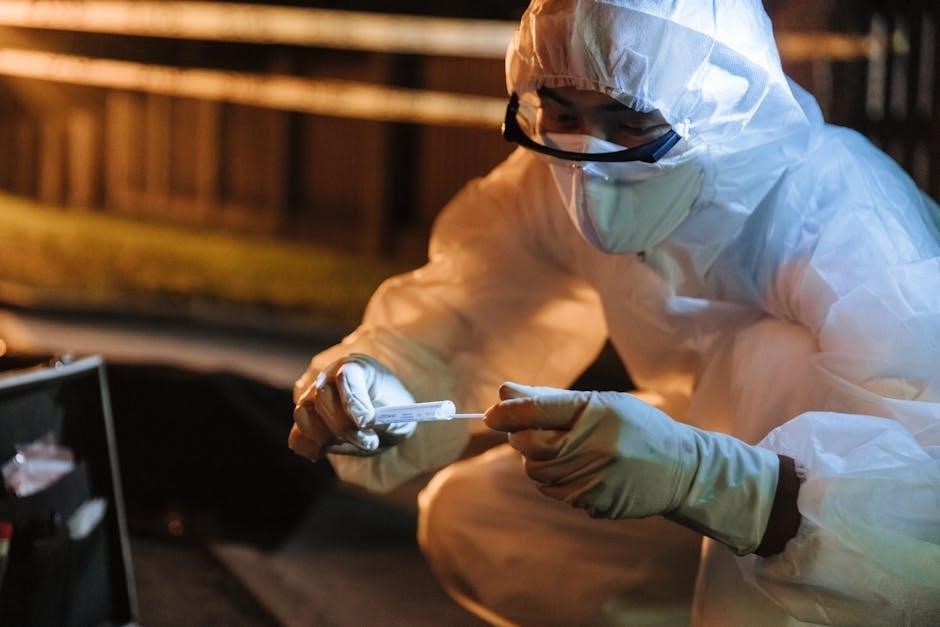Computer forensics investigations involve systematically gathering, analyzing, and preserving digital evidence to uncover facts in criminal, corporate, or legal matters. This field ensures digital evidence is handled with integrity, adhering to legal standards, and supports investigations through meticulous data recovery and analysis techniques.
1.1. Definition and Scope of Computer Forensics
Computer forensics is the scientific process of identifying, recovering, analyzing, and presenting digital evidence to investigate cybercrimes or data breaches. It involves legal and technical procedures to ensure the integrity and admissibility of electronic evidence. The scope spans data recovery from devices, network analysis, and forensic tools to uncover hidden or deleted information, aiding in legal proceedings and organizational investigations while maintaining ethical standards and privacy laws. This field is crucial in modern investigations due to the growing reliance on digital data.
1.2. Importance of Digital Evidence in Investigations
Digital evidence is critical in modern investigations, often serving as the only record of cybercrimes, data breaches, or unauthorized activities. It provides a factual basis for legal proceedings, helping to establish timelines, identify perpetrators, and validate claims. Digital evidence, such as logs, files, and messages, is frequently the most reliable and objective source of truth. Its integrity and admissibility in court make it indispensable for both criminal and civil cases, ensuring justice and accountability in an increasingly digital world.
1.3. Brief History and Evolution of Computer Forensics
Computer forensics emerged in the 1980s as law enforcement began addressing cybercrime. Early tools focused on recovering deleted files and analyzing floppy disks. The 1990s saw formal frameworks and specialized tools like EnCase and FTK. The 2000s brought advanced techniques for hard drives, mobile devices, and network analysis. Today, AI, cloud forensics, and encryption challenges shape the field, demanding continuous innovation to stay ahead of evolving digital threats and investigative demands.

Legal Considerations in Computer Forensics
Legal considerations in computer forensics ensure digital evidence is admissible in court, respecting privacy laws and maintaining chain of custody. Investigators must comply with jurisdictional regulations to avoid contamination and ethical violations, ensuring integrity throughout the process.
2.1. Admissibility of Digital Evidence in Court
For digital evidence to be admissible in court, it must meet strict legal standards. Relevance and reliability are key; evidence must directly relate to the case and be verified as authentic. Proper chain of custody ensures evidence hasn’t been altered, while compliance with legal procedures guarantees its integrity. Courts require clear documentation of how evidence was collected, stored, and analyzed to maintain admissibility. Non-compliance can lead to exclusion, undermining the investigation’s credibility and legal standing.
2.2. Chain of Custody and Its Significance
Chain of custody is a critical legal process documenting the handling and storage of digital evidence from collection to presentation in court. It ensures evidence integrity by recording every transfer, access, and storage detail. Proper documentation includes timestamps, personnel involved, and storage conditions. This chain validates the evidence’s authenticity, preventing tampering allegations. Without it, evidence may be deemed inadmissible, jeopardizing the case. Thus, maintaining an unbroken chain of custody is essential for upholding the credibility and legal standing of digital evidence in investigations.
2.3. Privacy Laws and Ethical Implications
Privacy laws, such as GDPR and CCPA, regulate the handling of personal data, ensuring individuals’ rights are protected during digital investigations. Investigators must comply with these laws to avoid legal repercussions. Ethical considerations require balancing the need for evidence with respect for privacy. Confidentiality and transparency are paramount to maintain trust and integrity in the investigative process, ensuring that digital forensics practices align with legal and moral standards without infringing on personal freedoms.
The Investigative Process
The investigative process in computer forensics involves systematically identifying, collecting, and analyzing digital evidence to reconstruct events. It ensures data integrity and adherence to legal and procedural standards.
3.1. Initial Assessment and Planning
The initial assessment involves understanding the scope and objectives of the investigation, identifying relevant data sources, and evaluating legal requirements. Planning includes defining investigative goals, allocating resources, and establishing timelines. It also involves selecting appropriate tools and protocols to ensure evidence integrity and adherence to legal standards. Proper documentation and communication strategies are essential during this phase to maintain clarity and direction throughout the process.
3.2. Securing and Preserving Digital Evidence
Securing and preserving digital evidence is critical to maintain its integrity and admissibility in legal proceedings. This involves isolating devices to prevent data alteration, using write-blockers to ensure no changes occur during extraction, and employing encryption to safeguard data. Proper documentation of the preservation process is essential, and hashing algorithms like MD5 or SHA-1 are used to verify data integrity. These steps ensure that evidence remains reliable and tamper-proof throughout the investigation.
3.3. Data Acquisition and Duplication
Data acquisition and duplication are pivotal steps in computer forensics, ensuring the integrity of digital evidence. Forensic tools like FTK Imager or EnCase create bit-for-bit copies of drives, capturing all data, including deleted files. The original drive is secured to prevent alteration, while the duplicate is analyzed. Hashing (MD5/SHA-1) verifies the copy’s authenticity, ensuring no data tampering. This process is crucial for maintaining evidence integrity and supporting legal proceedings.
3.4. Analysis of Digital Evidence
The analysis of digital evidence involves a thorough examination of acquired data to identify relevant information. Forensic tools like Autopsy and FTK Imager are used to analyze files, directories, and system logs. Techniques include keyword searches, registry analysis, and recovery of deleted or hidden data. This phase reconstructs events, identifies patterns, and extracts evidence, ensuring a comprehensive understanding of digital activities. Rigorous methodologies ensure the integrity and admissibility of evidence in legal proceedings.
3.5. Documentation and Reporting
Documentation and reporting are critical in computer forensics investigations, ensuring transparency and accountability. Detailed records of all steps, including data acquisition, analysis, and findings, must be maintained. The chain of custody is meticulously documented to verify evidence integrity. Reports are prepared in a clear, concise manner, presenting factual findings and supporting legal or organizational needs. Proper documentation ensures that digital evidence is admissible and understandable for stakeholders, including legal teams and decision-makers.

Tools and Techniques in Computer Forensics
Computer forensics employs specialized tools and techniques to extract, analyze, and interpret digital evidence. Hardware tools like forensic imagers capture data, while software tools such as FTK Imager and Autopsy enable in-depth analysis. Techniques include data recovery, network monitoring, and encryption handling, ensuring thorough and accurate investigations of digital artifacts.
4.1. Hardware Tools for Digital Forensics
Hardware tools in digital forensics are essential for securely handling and analyzing digital evidence. Write blockers prevent data alteration during duplication, ensuring evidence integrity. Forensic imagers create exact copies of drives, while portable write blockers enable on-site data acquisition. Additional tools include forensic bridges and acquisition devices, often equipped with hashing capabilities to verify data integrity. These hardware solutions are critical for conducting thorough and legally admissible investigations, ensuring data preservation and accurate analysis.
4.2. Software Tools for Forensic Analysis
Software tools are indispensable in digital forensics, enabling detailed analysis of evidence. Tools like EnCase, FTK, and Autopsy allow investigators to recover deleted files, analyze disk images, and identify hidden data. These tools support advanced features such as keyword searches, registry analysis, and malware detection. They also generate comprehensive reports, ensuring findings are presented clearly. Specialized software often includes encryption-breaking capabilities and tools for reconstructing timelines of digital events, aiding investigators in piecing together incidents and identifying suspicious activities.
4.3. Network Forensics and Monitoring
Network forensics involves analyzing network traffic to identify unauthorized activities, intrusions, or data breaches. Tools like Wireshark and Tcpdump capture and inspect packets, helping investigators trace malicious communications. Monitoring tools detect anomalies, while log analysis reveals patterns of suspicious behavior. These techniques enable the reconstruction of network events, aiding in identifying sources of attacks and gathering evidence for legal proceedings. Continuous monitoring ensures proactive threat detection, safeguarding networks from evolving cyber threats.
4.4. Mobile Device Forensics
Mobile device forensics involves extracting and analyzing data from smartphones, tablets, and other portable devices. Investigators use specialized tools like FTK Imager and Autopsy to recover deleted messages, call logs, and app data. Encryption and privacy features often pose challenges, requiring advanced techniques to bypass locks legally. Forensic tools also help track device locations and identify malicious apps; Proper handling ensures data integrity, preserving evidence for legal proceedings and maintaining user privacy throughout the investigation process.

Data Recovery and Reconstruction
Data recovery involves restoring lost or corrupted files, while reconstruction rebuilds fragmented data for forensic analysis. Techniques include file carving and handling encrypted data to ensure evidence integrity.
5.1. Techniques for Recovering Deleted Data
Recovering deleted data involves specialized techniques to restore files from storage devices. Methods include file carving, which extracts data from unallocated space, and logical recovery, which targets formatted or deleted partitions. Forensic tools like FTK Imager and Autopsy analyze disk sectors to identify and reconstruct deleted files. Encryption handling is also critical, ensuring data integrity during recovery. These techniques are essential in forensic investigations to retrieve evidence that may have been intentionally or accidentally removed.
5.2. File Carving and Data Reconstruction
File carving involves extracting files from raw disk data without relying on file system metadata. This technique is crucial when files are fragmented or metadata is corrupted. Data reconstruction rebuilds corrupted or damaged files by reassembling fragments. Forensic tools use algorithms to identify file headers and footers, enabling precise extraction. These methods ensure investigators recover intact digital evidence, even from severely compromised storage devices, aiding in comprehensive analysis and case resolution.
5.3. Handling Encrypted Data
Encrypted data presents a significant challenge in computer forensics, as it requires specialized techniques to decode. Investigators must identify encryption types, such as AES or RSA, and use decryption tools or keys to access data. Without proper authorization, accessing encrypted files can violate privacy laws. Forensic experts employ advanced tools to crack passwords or extract encryption keys, ensuring legal compliance. Handling encrypted data demands precision to maintain evidence integrity and adhere to ethical standards during investigations.

Handling Evidence
Properly handling digital evidence ensures integrity and admissibility in legal proceedings. This involves secure storage, anti-contamination measures, and strict documentation to maintain the chain of custody and authenticity.
6.1. Proper Storage and Transportation of Digital Evidence
Proper storage and transportation of digital evidence are critical to maintain its integrity. Evidence should be stored in secure, static-free environments using external drives or forensic images with hash verification. Transportation requires tamper-evident bags, clear labeling, and secure logging to prevent unauthorized access or contamination. Ensuring these steps helps maintain the evidence’s integrity and legal admissibility throughout the investigation process.
6.2. Anti-Contamination Measures
Anti-contamination measures are essential to prevent digital evidence tampering. Investigators must use write blockers to prevent data alteration during analysis. Static-free environments and sterile equipment minimize physical contamination. Secure, tamper-proof storage devices and encryption ensure digital integrity. Strict access controls, including dual authorization, further safeguard evidence. These measures ensure the integrity of digital evidence, maintaining its admissibility and reliability in legal proceedings, and uphold the credibility of the investigation process.
6.3. Verification and Validation of Evidence
Verification ensures digital evidence’s integrity by comparing hashes of original and copied data, confirming no alterations. Validation checks the relevance and reliability of evidence through cross-validation with multiple tools and techniques. Detailed documentation of processes and findings ensures transparency and accountability. These steps confirm the evidence’s admissibility in court, maintaining its credibility and reliability throughout the investigation process.

Training and Certification
Training and certification are essential for forensic investigators to master technical and legal skills. Certifications like CCE, GCFE, and EnCE validate expertise, ensuring professionals meet industry standards and stay updated on emerging technologies and methodologies.
7.1. Essential Skills for Forensic Investigators
Forensic investigators must possess a strong foundation in technical, legal, and analytical skills. Proficiency in operating systems, forensic tools, and data recovery techniques is critical. Knowledge of encryption, network protocols, and mobile device forensics is also essential. Investigators should understand legal frameworks, including privacy laws and evidence admissibility. Strong attention to detail, analytical thinking, and problem-solving abilities are vital for interpreting digital evidence accurately. Continuous learning is necessary to stay updated with emerging technologies and methodologies in the field.
7.2. Recommended Certifications
Key certifications for forensic investigators include Certified Computer Examiner (CCE), GIAC Certified Forensic Examiner (GCFE), and Certified Ethical Hacker (CEH). These credentials validate expertise in digital evidence handling, legal procedures, and advanced investigative techniques. Additionally, certifications like Certified Information Systems Security Professional (CISSP) provide a broader understanding of cybersecurity, enhancing investigative capabilities. These certifications demonstrate proficiency and commitment to professional standards in computer forensics, making investigators more credible in legal and professional settings.
7.3. Continuous Professional Development
Continuous professional development is crucial in computer forensics due to rapid technological advancements. Investigators must stay updated on new tools, techniques, and legal frameworks. Regular training, attending webinars, and pursuing advanced certifications ensure expertise remains current. Participation in workshops, conferences, and online courses fosters knowledge sharing and adaptability. Networking with peers and joining professional associations further enhances skills and awareness of emerging trends, ensuring investigators remain competent in addressing complex digital challenges effectively.
Challenges in Computer Forensics
Computer forensics faces challenges like rapid technological evolution, sophisticated cybercrimes, and large data volumes, requiring constant adaptation and advanced tools to maintain investigative effectiveness and integrity.
8.1. Overcoming Technical Limitations
Technical limitations in computer forensics pose significant challenges, such as compatibility issues with diverse hardware/software platforms and the inability to access encrypted or damaged data. Investigators must stay updated with cutting-edge tools and techniques to bypass these hurdles effectively. Additionally, the rapid evolution of technology demands continuous skill enhancement to handle emerging storage mediums and sophisticated encryption methods. Success in overcoming these limitations ensures the integrity and accuracy of digital evidence, which is critical for valid forensic outcomes.
8.2. Managing Large Volumes of Data
Managing large volumes of data in forensic investigations is challenging, requiring efficient tools and techniques to process and analyze vast amounts of information. Investigators must ensure that relevant evidence is identified without compromising accuracy. Advanced software and automation help streamline the process, enabling forensic experts to handle extensive datasets within tight timelines. Effective data management is crucial for maintaining the integrity of digital evidence and ensuring successful investigation outcomes.
8.3. Staying Ahead of Cybercriminals
Staying ahead of cybercriminals requires forensic investigators to continuously update their skills and tools. Cybercriminals constantly evolve their tactics, employing new technologies to evade detection. Investigators must adopt cutting-edge forensic techniques and leverage AI-driven solutions to identify sophisticated threats. Regular training, collaboration with cybersecurity experts, and adherence to global best practices ensure that forensic professionals remain proactive in countering emerging risks and safeguarding digital evidence effectively.

Future Trends in Computer Forensics
Future trends include AI-driven analysis, cloud forensics, and IoT investigations, with advancements in quantum computing reshaping encryption and data recovery methodologies, ensuring robust digital evidence handling.
9.1. Advancements in AI and Machine Learning
Advancements in AI and machine learning are revolutionizing computer forensics by enabling faster, more accurate analysis of large datasets. Predictive analytics and deep learning algorithms can identify patterns, detect anomalies, and automate evidence classification. AI-powered tools enhance forensic investigations by reducing manual effort and improving the precision of data recovery. Additionally, machine learning models can adapt to emerging threats, making them invaluable for proactive threat detection and incident response. These technologies are critical for staying ahead of sophisticated cybercriminals and ensuring robust digital evidence handling.
9.2. Cloud Computing and Its Impact
Cloud computing has transformed digital investigations, introducing new challenges for forensic experts. Data stored across multiple servers and jurisdictions complicates recovery and legal processes. Cloud environments often involve shared resources and dynamic IP addresses, making it difficult to pinpoint evidence. Investigators must adapt to these complexities, leveraging specialized tools to access and analyze cloud-based data securely. Additionally, privacy concerns and encryption in cloud storage require careful navigation to ensure compliance with legal standards while maintaining the integrity of digital evidence.
9.3. Emerging Technologies and Their Challenges
Emerging technologies like AI, blockchain, and IoT present both opportunities and challenges for computer forensics. AI can enhance analysis but may also create sophisticated attacks. Blockchain’s decentralized nature complicates data retrieval, while IoT devices generate vast, unsecured data. Quantum computing threatens current encryption methods. Investigators must adapt to these evolving technologies, balancing innovation with ethical considerations to maintain evidence integrity and stay ahead of cybercriminals in this dynamic landscape.
Computer forensics investigations are pivotal in resolving digital crimes and ensuring data integrity. By mastering tools, adhering to legal standards, and adapting to emerging technologies, investigators uncover crucial evidence. Continuous learning and ethical practices are essential to meet future challenges, making computer forensics indispensable in our increasingly digital world.
